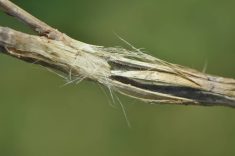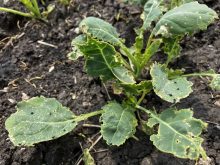Sub-zero temperatures were recorded in Southwest, Northwest, Central and Interlake stations overnight. Sub-zero temperature and duration of temperature are important factors to consider for their effect on immature crops.
Where frost occurred, crops susceptible at present maturity are canola, soybean and silage corn. Producers are cautioned that frost that occurred on greenfeed and corn can increase nitrates in feed.
Read Also

Canadian canola prices hinge on rain forecast
Canola markets took a good hit during the week ending July 11, 2025, on the thought that the Canadian crop will yield well despite dry weather.
The extent of frost damage to a crop will depend on several factors. The species, stage, and hardening of the crop, the soil type and soil moisture, the actual air temperature, the duration of freezing, and the rapidity with which freezing takes place are important. A drop in air temperature of short duration will cause less damage than a prolonged period the same low temperature.
Assessment of frost damage – The first signs of damage in canola can occur within the first 6 hours after the event as plant wilting (severe) or speckling seen on the pods. In soybeans, it may take longer to see damage and may be limited to killing upper leaves and have not had frost penetrate into the crop canopy. In corn, first signs of frost will appear in 1 to 2 days, appearing as water soaked lesions on leaves.
Canola
Information from Canola Council of Canada. Seeds with greater than 20 per cent moisture will be damaged by frost, as a reference, canola at 60 per cent seed colour change is approximately 30 per cent seed moisture.
If intention is to swath canola:
- Light frost (0C to -2 C) – Check in the afternoon and evening after the frost for wilting to assess frost damage, there may be speckling on the stem and pods, but this is of little concern as long as the plant is still alive and not wilting. If no wilting, leave the crop standing and check daily for seed colour change to indicate swath timing.
- Heavy frost (> -2 C) – Assess the damage in early afternoon. Check pods for a white, wilted appearance. Pod shatter and pod drop could begin within a day, especially with warm sunny afternoons. If pods are desiccating rapidly, swathing right away will preserve as much yield as possible. If the pods are severely damaged and are beginning to desiccate, swath during periods of dew or high humidity to reduce the amount of pod shelling and pod drop.
If intention is to straight cut, see Canola Council information on Frost on Canola Left for Straight Combining.
Soybean
Using the Manitoba Pulse and Soybean Growers soybean maturity guide, determine the growth stage of your crop using pictures and descriptions.
In terms of yield loss, use the following as a guide:
- Frost during the R5 stage – reduce yield by 50 per cent-70 per cent.
- Frost at the R6 stage – reduce yield by 20 per cent-30 per cent.
- Frost at the R7 stage – reduce yield by only about 5 per cent.
- Frost at R8 stage – no yield reductions expected. Besides yield loss, there is also the increased concern of green seed issues. This occurs when there is rapid dry down in the plant and seed – e.g. when frost occurs or when hot/dry weather causes premature and fast ripening. Corn (Silage) – A killing frost occurs when temperatures reach at or below 0C for 4+ hours. In terms of yield loss, use the following as a guide. Frost at R4 (dough) – kernel moisture of around 70 per cent and too high of moisture to be ensiled successfully. This crop will need to dry in the field for several days and monitored closely for moisture content. Frost at R5 (dent), stage according to the progression of the milk line, i.e. ¼, ½, ¾. At ½ milk line (R5.5), moisture content of kernels is 35-40 per cent. Frost occurring during the R5 stage in silage corn will require harvest right away before leaves start shedding or plant breakage occurs, to prevent yield loss


















